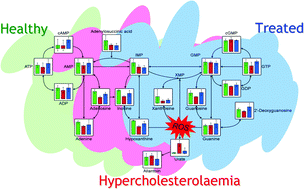Metabolomic anatomy of an animal model revealing homeostatic imbalances in dyslipidaemia†
Abstract
Metabolomics is an emerging technology that reveals homeostatic imbalances in biological systems. Global determination of

* Corresponding authors
a
Human Metabolome Technologies, Inc., 246-2 Mizukami, Kakuganji, Tsuruoka, Yamagata 997-0052, Japan
E-mail:
ohashi@humanmetabolome.com
Fax: +81-235-25-1450
Tel: +81-235-25-1447
b Institute for Advanced Biosciences, Keio University, Tsuruoka, Yamagata 997-0052, Japan
Metabolomics is an emerging technology that reveals homeostatic imbalances in biological systems. Global determination of

 Please wait while we load your content...
Something went wrong. Try again?
Please wait while we load your content...
Something went wrong. Try again?
T. Ooga, H. Sato, A. Nagashima, K. Sasaki, M. Tomita, T. Soga and Y. Ohashi, Mol. BioSyst., 2011, 7, 1217 DOI: 10.1039/C0MB00141D
To request permission to reproduce material from this article, please go to the Copyright Clearance Center request page.
If you are an author contributing to an RSC publication, you do not need to request permission provided correct acknowledgement is given.
If you are the author of this article, you do not need to request permission to reproduce figures and diagrams provided correct acknowledgement is given. If you want to reproduce the whole article in a third-party publication (excluding your thesis/dissertation for which permission is not required) please go to the Copyright Clearance Center request page.
Read more about how to correctly acknowledge RSC content.
 Fetching data from CrossRef.
Fetching data from CrossRef.
This may take some time to load.
Loading related content
